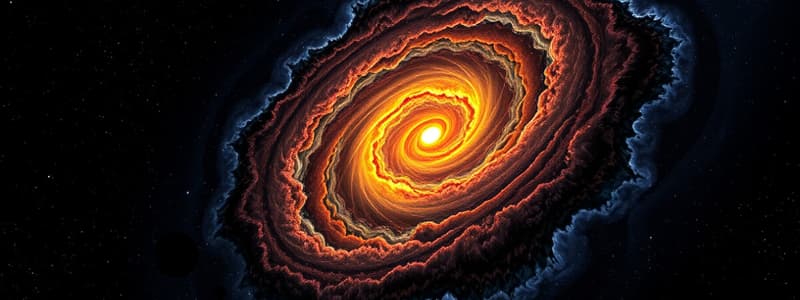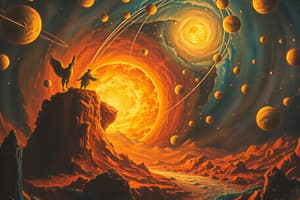Podcast
Questions and Answers
The Nebular Theory suggests that the solar system originated from a star cluster.
The Nebular Theory suggests that the solar system originated from a star cluster.
False (B)
In the formation of a protoplanetary disk, materials at the center become denser as the cloud collapses.
In the formation of a protoplanetary disk, materials at the center become denser as the cloud collapses.
True (A)
Jovian planets formed close to the sun due to higher temperatures allowing gases to condense.
Jovian planets formed close to the sun due to higher temperatures allowing gases to condense.
False (B)
According to Encounter Theory, the planets formed from dust clumps around a central sun-like body.
According to Encounter Theory, the planets formed from dust clumps around a central sun-like body.
The first step in the formation of the solar system involves the growth of planetesimals.
The first step in the formation of the solar system involves the growth of planetesimals.
The Nebular Theory suggests that planets formed from materials ejected from the sun during encounters with other celestial bodies.
The Nebular Theory suggests that planets formed from materials ejected from the sun during encounters with other celestial bodies.
According to the Encounter Theory, planets were formed from the materials ejected from a celestial object due to a close encounter with the sun.
According to the Encounter Theory, planets were formed from the materials ejected from a celestial object due to a close encounter with the sun.
The Planetesimal Theory is considered the most widely accepted explanation for planet formation today.
The Planetesimal Theory is considered the most widely accepted explanation for planet formation today.
Uranus and Venus rotate in a counterclockwise direction, which aligns with the predictions of the Nebular Theory.
Uranus and Venus rotate in a counterclockwise direction, which aligns with the predictions of the Nebular Theory.
The gravitational pull from a passing star leads to the contraction of materials in the protoplanetary disk.
The gravitational pull from a passing star leads to the contraction of materials in the protoplanetary disk.
Hot material from the sun expands and dissipates, which poses a problem for the Planetesimal Theory.
Hot material from the sun expands and dissipates, which poses a problem for the Planetesimal Theory.
The Protoplanetary Disk Formation is a phrase often associated with the Nebular Theory and describes how planets coalesce.
The Protoplanetary Disk Formation is a phrase often associated with the Nebular Theory and describes how planets coalesce.
Laplace was a proponent of the Encounter Theory.
Laplace was a proponent of the Encounter Theory.
The Tidal Theory suggests that planets formed from condensed hot gas after a near collision with a passing star.
The Tidal Theory suggests that planets formed from condensed hot gas after a near collision with a passing star.
The Tidal Theory was developed by Albert Einstein and Niels Bohr in 1918.
The Tidal Theory was developed by Albert Einstein and Niels Bohr in 1918.
According to Tidal Theory, planets could form because the hot material from a passing star can contract.
According to Tidal Theory, planets could form because the hot material from a passing star can contract.
The Encounter Theory is often associated with the formation of the solar system through planetary accretion.
The Encounter Theory is often associated with the formation of the solar system through planetary accretion.
In the Nebular Theory, a protoplanetary disk is formed from the gas and dust surrounding a young star.
In the Nebular Theory, a protoplanetary disk is formed from the gas and dust surrounding a young star.
The Big Crunch Theory suggests the universe will eventually expand forever without collapsing back.
The Big Crunch Theory suggests the universe will eventually expand forever without collapsing back.
In the Oscillating Universe Theory, the universe undergoes cycles of expansion and contraction.
In the Oscillating Universe Theory, the universe undergoes cycles of expansion and contraction.
Protoplanetary disks can form through the remnants of supernova explosions alone.
Protoplanetary disks can form through the remnants of supernova explosions alone.
Flashcards are hidden until you start studying
Study Notes
Nebular Theory
- Proposes the solar system originated from a nebula.
- Major steps: Cloud Collapse, Formation of Protoplanetary Disk, Growth of Planets.
Steps in Formation
-
Step 1: Cloud Collapse
- Caused by shockwaves from supernovae or the influence of a passing star.
- Resulting collapse leads to a smaller radius and faster spin of the cloud.
-
Step 2: Formation of Protoplanetary Disk
- Materials at the center become denser during the collapse.
- Higher boiling point materials like metals and silicates formed near the sun created terrestrial planets.
- Gas-rich jovian planets formed further from the sun due to cooler temperatures allowing gas condensation.
-
Step 3: Growth of Planets
- Dust and grains around the sun formed clumps that became planetesimals.
- Planetesimals are small celestial bodies that collide and fuse to form planets.
Proponents of the Nebular Theory
- Pierre-Simon Laplace
- Immanuel Kant
- Emanuel Swedenborg
Drawbacks of the Nebular Theory
- Some particles around Saturn repel each other, conflicting with the theory.
- Fails to explain the angular momentum law.
- Does not account for the clockwise rotation of Uranus and Venus versus other planets.
Encounter Theory
- Suggests planets formed from materials ejected by the sun during a close encounter with another celestial body.
- Involves an intruding star nearly colliding with the protosun, leading to material ejection.
Planetesimal Theory
- Proposed by Thomas Chrowder Chamberlin, emphasizing planet formation through accretion of solid particles.
- Mathematical backing provided by Forest Ray Moulton.
Drawbacks of the Planetesimal Theory
- No longer accepted due to the behavior of hot material from the sun, which dissipates rather than contracts.
- Passing star’s gravity would disperse dust and gases, hindering planet formation.
Tidal Theory
- Formulated by James Jeans and Harold Jeffreys in 1918.
- Claims the solar system arose from a near collision between the sun and a passing star, resulting in hot gas condensing into planets.
Drawbacks of the Tidal Theory
- Hot material from either celestial body cannot contract, preventing planet formation.
Future Topics
- Lesson 2: Exploration of life on Earth and its conditions.
- Topics include the origin of Earth, the role of water, the sun as an energy source, and Earth’s atmosphere.
Studying That Suits You
Use AI to generate personalized quizzes and flashcards to suit your learning preferences.




